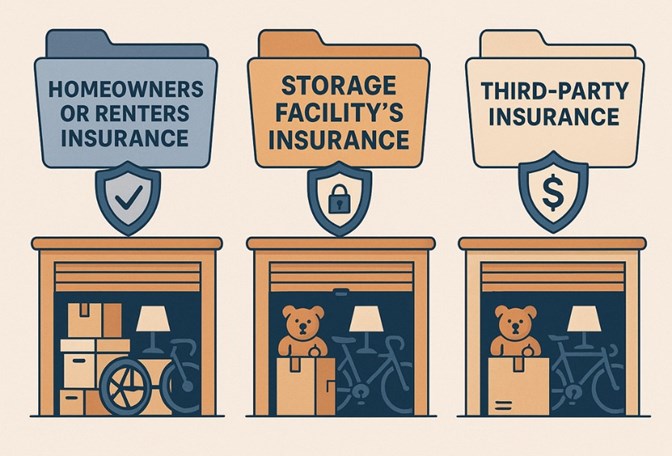Storage insurance may be mandatory, depending on your facility. And even if it isn’t, having storage unit insurance is an extra layer of defense in case of damage or theft. There are three main options to choose from:

1. Homeowner or Renters Insurance
This is the most convenient option, because ideally, you should have homeowners insurance already. Some insurance plans already include coverage for storage units, and if yours doesn’t, there’s a strong probability your insurance provider will be open to upgrading your plan.
If your homeowners or renters insurance already covers your storage needs, you’re in the clear. The only downside is it may be overkill depending on your needs.
Look at it this way: If you have a house, sure, you’ll need a broad-reaching homeowners insurance plan. But let’s say you’re leaving the country for an extended period of time, and you just need to put your stuff in storage while you’re living it up somewhere else. In a storage-first case like this, consider your other options.
2. Storage Facility’s Insurance
Again, pretty darn convenient. Storage facilities are oftentimes nice enough to offer their own insurance plans, which you can sign on to when you’re booking your storage unit. This coverage isn’t super expensive: Some places offer up to $10,000 worth of coverage for $20 a month. And since you’re already going to be paying them a monthly fee, it’s not a tough sell.
The biggest downside we’ve seen with insurance provided by a storage facility? Gaps in coverage. Some storage providers may not offer insurance payouts for certain types of damage - whether it’s bugs, mold, or other unpleasantries. Always read the fine print of whatever policy they’re offering.
Here’s a pro tip: Before you even book storage, take a close look at what’s not covered by a facility’s insurance plan and check the BBB or Consumer Affairs for reviews, and always read the fine print for gaps in coverage. Gaps exist for a reason, and if a facility doesn’t want to cover a certain kind of damage, it may mean it happens frequently at their location.
3. Third-Party Insurance
Finally, you’ve got third-party storage unit insurance. If you want extensive coverage without the overkill of a complete homeowners or renters insurance policy, you can snag third-party storage insurance for a moderate fee (usually from $7 to $30 a month). Third-party insurance is also a great option if you want a higher dollar amount for your coverage - although if you’re storing really valuable stuff, you may want to rethink a storage unit altogether.
Third-party insurance can be kind of a hassle to track down. There are a lot of providers out there, and you’ll have to do quite a bit of shopping around.
Here’s a quick breakdown of your storage insurance options:



